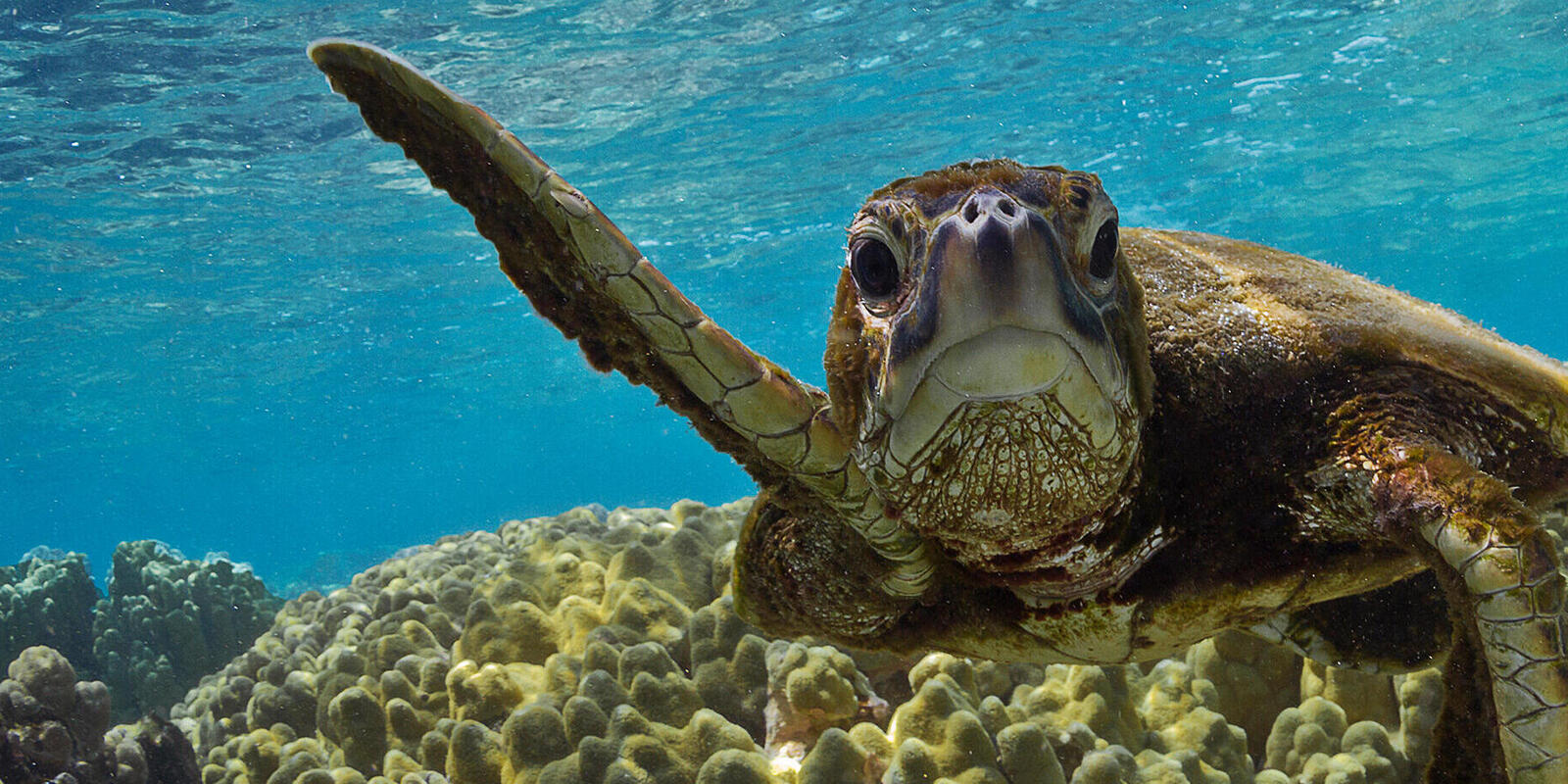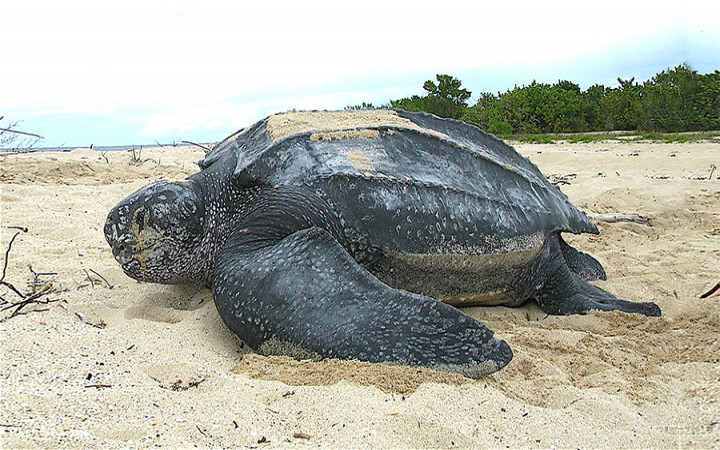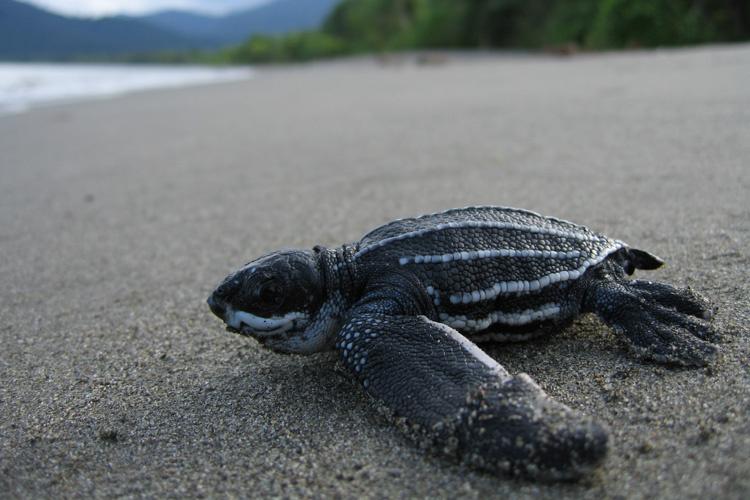Leatherback sea turtles survive by having a unique physiology and behavior that adapts to their marine environment. These turtles have a thick, rubbery skin, a streamlined body shape, and can regulate their body temperature to withstand cold waters.
Their large size also helps them to dive deep and navigate long distances in search of food. Additionally, leatherback sea turtles have a specialized diet of jellyfish, which provides them with the necessary nutrients to thrive in their ocean habitat.
This species of sea turtle has evolved over millions of years to develop strategies that allow them to survive and thrive in the challenging marine environment they call home.

Credit: www.nwf.org
Unique Characteristics Of Leatherback Sea Turtles
Leatherback sea turtles are remarkable creatures with unique characteristics that enable them to thrive in their oceanic habitat. These fascinating reptiles possess several distinctive traits that contribute to their survival, including their diverse diet and efficient thermoregulation.
Diverse Diet
Leatherback sea turtles have a diverse diet, consisting primarily of jellyfish, but they also consume other gelatinous organisms such as salps and comb jellies. This wide-ranging diet allows them to adapt to varying food availability in different oceanic regions, contributing to their resilience in the face of environmental changes.
Efficient Thermoregulation
One of the most impressive characteristics of leatherback sea turtles is their efficient thermoregulation. Unlike other sea turtle species, leatherbacks can maintain their body temperature in cold water environments due to their unique adaptations, such as a thick layer of insulating fat and specialized circulation systems. This ability to regulate their body temperature enables them to inhabit a wide range of oceanic climates, from tropical waters to colder regions, giving them a competitive edge in their marine environment.
Migration Patterns Of Leatherback Sea Turtles
Migration patterns of leatherback sea turtles are a fascinating aspect of their behavior. These ancient creatures undertake incredible journeys across oceans, traveling thousands of miles to find the ideal environment for nesting and feeding.
Long-distance Travel
Leatherback sea turtles are known for their remarkable ability to travel vast distances. They migrate from their feeding grounds in cooler waters to nesting beaches in warmer climates. These migrations can span across entire ocean basins, with some leatherback sea turtles traveling from as far as the Arctic to tropical regions.
Navigational Abilities
Leatherback sea turtles possess impressive navigational abilities, allowing them to navigate through the open ocean with remarkable precision. They are believed to rely on a combination of cues, including the Earth’s magnetic field, celestial navigation, and possibly even the ocean’s currents and temperature gradients to guide their migration routes. This remarkable sense of direction enables them to return to the same nesting beaches year after year, despite the vast distances traveled.
Reproduction And Nesting Habits
Leatherback sea turtles are fascinating creatures that have evolved unique adaptations to help them survive in the ocean. One of the most interesting aspects of their life cycle is their reproduction and nesting habits. In this section, we will explore the mass nesting events and challenges faced by hatchlings.
Mass Nesting Events
Leatherback sea turtles are known for their mass nesting events, also known as arribadas. During these events, thousands of female turtles come ashore to lay their eggs on the same beach. This behavior is thought to be a survival strategy, as the sheer number of eggs laid increases the chances of some of them hatching and surviving to adulthood.
The nesting process is fascinating to observe. The female turtle uses her powerful flippers to dig a hole in the sand, where she will deposit her eggs. After laying the eggs, she carefully covers them with sand and then returns to the ocean. The entire process can take several hours.
Challenges Faced By Hatchlings
Once the eggs hatch, the baby turtles face a variety of challenges as they make their way to the ocean. One of the biggest challenges is predation. Many predators, including birds and crabs, are waiting to feast on the tiny turtles as they emerge from the sand.
Another challenge is disorientation. Hatchlings use the reflection of the moon and stars on the ocean’s surface to guide them to the water. However, artificial lighting from nearby buildings and streetlights can confuse them and cause them to head in the wrong direction. This is why it’s important to reduce the amount of light pollution near nesting beaches.
Despite these challenges, some hatchlings do make it to the ocean, where they will spend the next several years of their lives growing and developing. Leatherback sea turtles are truly amazing creatures, and their survival depends on the conservation efforts of humans around the world.
Predators And Threats To Leatherback Sea Turtles
Leatherback sea turtles, the largest of all sea turtle species, have evolved to survive in the harsh marine environment, but they face numerous challenges, particularly from predators and human-induced threats. Understanding the natural predators and human-induced threats to leatherback sea turtles is crucial to their conservation and protection.
Natural Predators
Leatherback sea turtles have a few natural predators, including sharks, killer whales, and large predatory fish. While adult leatherback sea turtles are less vulnerable to predation due to their size and tough, leathery shell, their eggs and hatchlings are at greater risk. The eggs are often preyed upon by animals such as raccoons, foxes, and birds, while hatchlings face threats from seabirds and fish when they make their perilous journey from the nest to the ocean.
Human-induced Threats
Unfortunately, leatherback sea turtles face a multitude of threats caused by human activities. These threats include habitat destruction through coastal development, pollution from marine debris, entanglement in fishing gear, and illegal poaching for their meat, eggs, and shells. Climate change also poses a significant threat, leading to rising sea levels, changes in ocean currents, and alterations in the turtles’ nesting habitats.
Conservation Efforts To Protect Leatherback Sea Turtles
Leatherback sea turtles are facing numerous threats to their survival, such as habitat destruction, bycatch in fishing gear, and climate change. Conservation efforts play a crucial role in protecting these magnificent creatures, ensuring their continued existence for future generations. Let’s explore the initiatives that are helping to safeguard leatherback sea turtles.
International Conservation Agreements
International conservation agreements, such as the Convention on International Trade in Endangered Species of Wild Fauna and Flora (CITES), are essential for safeguarding leatherback sea turtles. These agreements facilitate cooperation among countries to regulate and monitor the trade of endangered species and their products, providing vital protection for leatherback sea turtles across their range.
Community-based Initiatives
Community-based initiatives play a pivotal role in the conservation of leatherback sea turtles. By engaging local communities in conservation efforts, these initiatives promote sustainable practices and raise awareness about the importance of protecting sea turtle habitats. Through education, outreach programs, and collaboration with local stakeholders, community-based initiatives contribute to the preservation of leatherback sea turtles and their nesting sites.

Credit: www.worldwildlife.org
Research And Monitoring Of Leatherback Sea Turtles
Leatherback sea turtles survive through their unique adaptations such as a flexible shell and specialized diet of jellyfish. Research and monitoring efforts play a crucial role in understanding and protecting these endangered species. These turtles’ ability to navigate vast ocean distances and withstand various environmental challenges contributes to their survival.
Leatherback sea turtles are one of the oldest creatures on the planet, having survived for more than 100 million years. Despite their resilience, these majestic creatures are currently facing a number of threats that are pushing them towards extinction. To ensure their survival, researchers and conservationists are working hard to better understand their behavior, habitat, and migration patterns through research and monitoring efforts.Technological Innovations
One of the key tools in the fight to save leatherback sea turtles is technology. Thanks to innovative new tools, researchers are able to track the movements of these creatures in real-time, allowing them to better understand their behavior and migration patterns. For example, satellite tracking devices are now being used to monitor the movements of leatherback sea turtles as they travel across the ocean. This information is then used to identify key habitats and breeding areas, which can then be protected from human activity.Population Studies
In addition to tracking the movements of leatherback sea turtles, researchers are also conducting population studies to better understand the overall health of these creatures. By monitoring the number of leatherback sea turtles in a given area, researchers can identify trends and patterns that can help inform conservation efforts. For example, if a particular population is declining rapidly, conservationists can focus their efforts on protecting that specific population.Conclusion
Through innovative research and monitoring efforts, we are gaining a better understanding of how leatherback sea turtles survive in the wild. With this knowledge, we can work to protect these creatures from the many threats they face, ensuring that they continue to thrive for generations to come.Impact Of Climate Change On Leatherback Sea Turtles
The leatherback sea turtles have adapted to the impact of climate change by utilizing their large size and unique physiological features to regulate body temperature. Their ability to dive deep into the ocean helps them escape extreme heat, while their streamlined bodies aid in efficient swimming to find cooler waters.
These survival strategies enable leatherback sea turtles to navigate the challenges posed by climate change.
Impact of Climate Change on Leatherback Sea Turtles Changing Ocean Conditions The leatherback sea turtles’ survival is significantly affected by changing ocean conditions. Rising sea temperatures can impact the turtles’ food sources, leading to a reduction in prey availability. Additionally, acidification of the ocean can affect the availability of jellyfish, a primary food source for leatherbacks, as it can impact the reproductive success of jellyfish, thus reducing the availability of food for the turtles. Nesting Site Vulnerability Climate change also poses a threat to leatherback sea turtles through the vulnerability of their nesting sites. Rising sea levels can lead to the erosion of nesting beaches, reducing the available nesting area. This can result in increased competition for suitable nesting sites, potentially impacting the reproductive success of leatherback sea turtles. In addition, extreme weather events such as storms and hurricanes, which are intensified by climate change, can destroy leatherback sea turtle nesting sites, leading to a reduction in successful nesting events. Overall, the impact of climate change on leatherback sea turtles is a significant concern, as it affects their food sources and nesting sites, ultimately threatening their survival.
Credit: wonderopolis.org
Educational Programs And Awareness Campaigns
When it comes to the conservation of leatherback sea turtles, educational programs and awareness campaigns play a crucial role in ensuring the survival of these magnificent creatures. By engaging local communities and implementing school outreach programs, these initiatives help foster a deeper understanding of the threats faced by leatherback sea turtles and empower individuals to take positive action to protect them.
Engaging Local Communities
Engaging local communities is vital in raising awareness about the importance of leatherback sea turtle conservation. Through interactive workshops, beach clean-up events, and educational seminars, community members can learn about the impact of human activities on the turtles’ habitats and how they can contribute to their preservation.
School Outreach Programs
School outreach programs play a pivotal role in educating the younger generation about the significance of leatherback sea turtle conservation. By incorporating engaging activities, such as guided nature walks, art projects, and interactive presentations, students gain a deeper appreciation for these endangered species and are inspired to become stewards of the environment.
Conclusion
In the end, the resilience of leatherback sea turtles is truly remarkable. Their ability to adapt to various environments and thrive in the vast oceans showcases the wonders of nature. By understanding their survival strategies, we can appreciate and protect these magnificent creatures for generations to come.





Leave a Reply